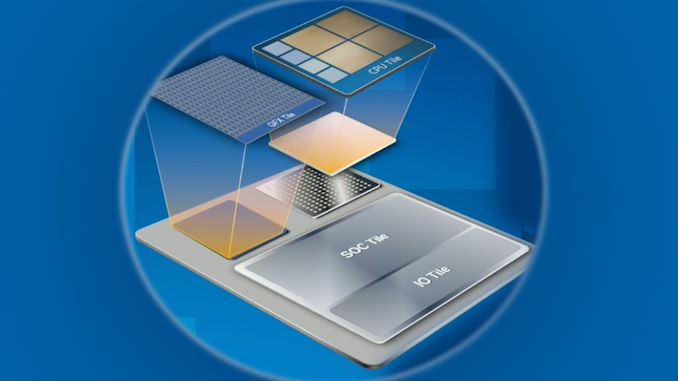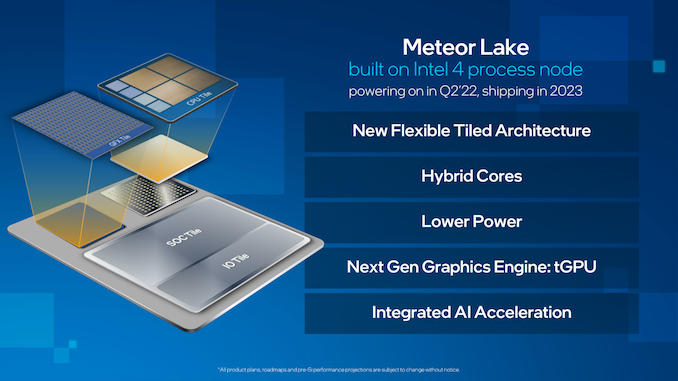Intel: Meteor Lake & Intel 4 Process Now Ramping for Production
by Ryan Smith on April 27, 2023 4:50 PM EST- Posted in
- CPUs
- Intel
- Meteor Lake
- Intel 4

As part of today’s Q1’2023 earnings announcement from Intel, the company is offering a brief update on the state of its upcoming chips and manufacturing nodes. Key among these disclosures is a status update on Meteor Lake, Intel’s next-generation client processor (and first disaggregated chiplet CPU), as well as the Intel 4 process node that it will be built upon.
According to Intel, the company is on track to launch Meteor Lake in the second half of the year. And more specifically, at this point Meteor Lake is now in production and ramping alongside the new Intel 4 process.
The basis of what we expect will be sold as Intel’s 14th generation of Core processors, Meteor Lake is a critical part for Intel that represents several firsts for the company. It’ll be the first client CPU using chiplets, but also the first heterogenous chiplet CPU from the company, using different chiplets for I/O, CPU cores, graphics, and more. And on the manufacturing side of matters, it’s going to be the lead product for Intel’s next-generation EUV-based Intel 4 process node, as well as Intel’s biggest use of Foveros 3D die stacking technology yet – and the first attempt to do so for a relatively cheap, mass-market processor.
Intel’s last significant update on Meteor Lake came almost exactly a year ago, when the company announced during their Q1’2022 earnings report that it had been successfully powered on for testing. So at a year later, Intel is now making final preparations for a product launch later this year. The official launch window is still in the second half of the year – Intel client processor ramp-ups take several months even without all-new manufacturing technologies in play – so we expect Intel will announce more concrete details on that launch some time in the third quarter.
Source: Intel











18 Comments
View All Comments
TristanSDX - Thursday, April 27, 2023 - link
How this play with rumored / leaked Raptor Lake Refresh release ? Intel is silent about that refresh, and other leaks suggest MTL for desktop to be launched anyway.For Intel launch mean 'silicon out of factory' not 'in shops'
Dolda2000 - Thursday, April 27, 2023 - link
Well, the rumors are that MTL will be used primarily for laptop, and *possibly* also for some i5 variants. Not saying that's what's going to happen, but that's what the rumor mill is saying.ikjadoon - Sunday, May 7, 2023 - link
So yields are still rather poor and this is just getting pushed out the door to meet executive timelines.— 1st 14nm CPU was basically only mobile (Broadwell)
— 1st 10nm CPU was basically only mobile (Ice Lake and Cannon Lake)
— 1st 7nm (Intel 4) CPU will be primarily mobile
See, TSMC does the same ramp (~90 to 110 mm^2 iPhone chips first), but they're humble enough to admit it as normal and part of the process.
Intel? "Oh, God, no. QUICK, a re-brand! Confuse the customers!"
Dolda2000 - Friday, May 12, 2023 - link
>So yields are still rather poor and this is just getting pushed out the door to meet executive timelines.Again, not to ascribe the rumor mill any particular degree of truth, but the rumors are that it's not the process, but the architecture teams that are delaying high-end MTL. Apparently, again according to rumors, the laptop and desktop variants are worked on by different teams, and apparently the desktop team is having troubles, and so supposedly that's why Intel is launching what was intended as laptop CPUs as desktop i5s.
Drumsticks - Thursday, April 27, 2023 - link
If I had to guess, we will see meteor like for mobile, and possibly as a show off SKU for their power efficiency per core or something in the lower desktop segments. If you believe the rumor mill, the eight P core parts were dropped, probably for cost savings given the time., Which would mean they could launch lower P core parts for lower segment parts, while retaining some kind of boosted raptor lake for the new i9s.bansheexyz - Thursday, April 27, 2023 - link
I think it's time to unify mobile and desktop chips somehow, I'm tired of waiting an extra 6 months for desktop versions.goatfajitas - Friday, April 28, 2023 - link
They have always been unified. The only difference is that on some generations of CPU Intel makes them mobile or desktop only, or for a period of time depending on what suits thier business needs. Production estimates, sales estimates, economics etc.drothgery - Friday, April 28, 2023 - link
It's been clear for a while that they're not doing this, but it's never been clear to me why they weren't planning on something like this:Desktop & HX i7 & i9 - 2x compute tile + small GPU tile + desktop IO tile (aka would top out at 12P + 16E)
Desktop & HX i3 & i5 - 1x compute tile + small GPU tile + desktop IO tile
H, P, and U series - 1x compute tile + big GPU tile + laptop IO tile
jjjag - Monday, May 1, 2023 - link
Because that is the holy grail of SOC architecture, and the more flexibility you design in, the more expensive it will be to produce it. Remember that packages, interposers, VRs, and other components have limits -- physically, mechanically and electrically. Look at all the wasted space on a Zen3 with only one of the CCD populated. So right there you can see the package is way more expensive to accommodate the flexibility. Also why is there that huge gap between the IO die and the CCDs? Because the technology did not exist at the time to put them all on a passive base die for a reasonable cost. Intel waited too long to make the leap to disaggregating client SOCs, and it took them an extra 3 years to figure out what was wrong with 10nmdrothgery - Tuesday, May 2, 2023 - link
Eh, desktop and HX parts are niche anyway, and as you said it'd basically be what AMD's doing there anyway.Non-HX laptop parts (aka where the real high volume is) wouldn't have any extra space.